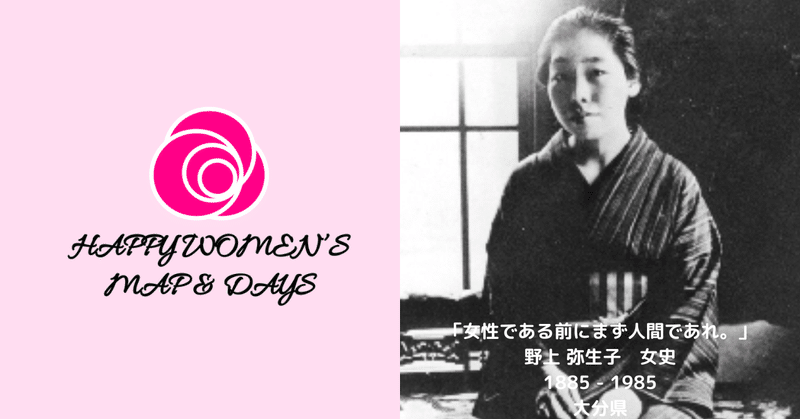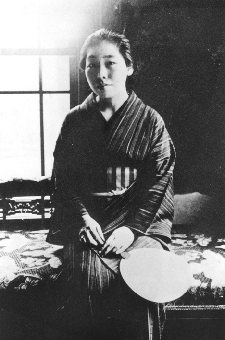
Happy Women's Map 大分県 日本女性初の文化勲章受章小説家 野上弥生子 女史

野上 弥生子 女史
Ms. Yaeko Nogami
1885 - 1985
大分県臼杵市 生誕
Born in Usuki-city, Oita-ken
「女性である前にまず人間であれ。」
"Before anything else, be human, regardless of being a woman."
野上弥生子女史は女性作家として初めて文化勲章を受章した小説家です。戦争そして敗戦へ向かう時代を重層的に描いている『迷路』は戦後文学の代表作とされています。彼女の生家の味噌醤油を運ぶ高吉丸の船長から聞き及んだ遭難中の恐ろしい出来事について描いている『海神丸』はカニバリズム小説の先駆けとされています。
Ms. Yoshiko Nogami is a novelist who became the first female writer to receive the Order of Culture, a prestigious honor in Japan. Her novel "Meiro (Labyrinth)" is regarded as a representative work of post-war literature, depicting the era leading up to the war and the subsequent defeat in a multi-layered manner. "Kaishinmaru (Sea God)", inspired by the horrifying events during a shipwreck that she heard from the captain of the Takayoshi-maru, a vessel transporting her family's miso and soy sauce, is considered a precursor to cannibalism literature.
*******
弥生子は大分県臼杵町の小手川酒造(後のフンドーキン醤油)の長女として生まれ、幼少から国文・漢文・英語を習います。東京の叔父方に身を寄せ明治女学校普通科に通います。夏目漱石門下の野上豊一郎と結婚。豊一郎を介して1m半に及ぶ巻紙の長い書簡で漱石から丁寧な添削指導を受け、『縁』を書きあげると、さらに漱石の推薦により『ホトトギス』に掲載され22歳で作家デビューを果たします。「もし文学者たらんと欲せば漫然として年をとるべからず、文学者として年をとるべし」の批評を大切に、99歳で没するまで息長く旺盛な作家活動を続けます。弥生子の母校・明治女学院の厳本善治をめぐるスキャンダルならびに校舎全焼をモデルに『放火殺人犯』を、実家に出入りする渡辺徳蔵という船乗りが遭遇した実話をもとに『海神丸』を、資本主義経済で衰退する東北の地主に嫁いだ同級生をモデルに『腐れかけた家』を、共産党員の宮本百合子をモデルに『真知子』を、長男が通う高等学校での学生ストライキをモデルに『若い息子』を書きあげます。さらに、夫や息子を戦場に送り出す女性たちのために『迷路』を書き始めますが、日中戦争が勃発。一時中断せざるを得ず、日英交換教授として渡欧した夫に同行、スペイン動乱はじめパリでのドイツ軍による開戦の報など第二次世界大戦の開戦を間近で体験、またアメリカの強大な国力や工業力に脅威を抱きます。敗戦後『迷路』を再開、戦前戦後と20年かけて完結します。夫亡き後は、法政大学女子高等学校名誉校長を務めたり、哲学者田辺元との「老年の恋」を楽しんだりしながら、明治女学校を舞台とした自伝的小説「森」の執筆を開始、完成を目前に永眠します。
Yayoiko was born as the eldest daughter of Kotegawa Sake Brewery in Usuki Town, Oita Prefecture (later known as Hundo-kin Soy Sauce). From a young age, she studied Japanese literature, classical Chinese, and English. She moved to Tokyo to live with her uncle and attended Meiji Women's School in the regular course. She married Nogami Toyichiro, a disciple of Natsume Soseki. Through Toyichiro, she received meticulous guidance and editing from Soseki through lengthy scrolls of letters, leading her to complete her work "Enishi." With Soseki's recommendation, her work was published in "Hototogisu," marking her debut as an author at the age of 22. She cherished Soseki's critique of "If you desire to be a literary person, you should not grow old aimlessly, but grow old as a literary person." She continued her prolific writing career vigorously until she passed away at the age of 99. Drawing from the scandal surrounding Meiji Women's School and its principal Yozaburo Sugimoto, as well as the model of a ship's sailor named Tokuzo Watanabe who frequented her family's home, she wrote "Hōka Satsujinhan" (Arson Murderer). Drawing from the true story of a seafarer named Tokuzo Watanabe who encountered the sinking of the ship "Kaishinmaru," she wrote "Kaishinmaru." Drawing from the model of a classmate who married into a declining landowning family in Tohoku's capitalist economy, she wrote "Kusare Kaketa Ie" (The Decaying House). Drawing from the model of a Communist Party member named Miyoko Miyamoto, she wrote "Machiko." Drawing from the student strike at the high school her eldest son attended, she wrote "Wakai Musuko" (Young Son). Furthermore, she began writing "Meiro" (The Labyrinth) for the women who sent their husbands and sons to the battlefield. However, the outbreak of the Second Sino-Japanese War interrupted her work. She accompanied her husband, who was a visiting professor in England, and experienced the impending outbreak of World War II firsthand, including the Spanish Civil War and the news of the war declaration by Germany in Paris. She also perceived the threat posed by America's immense national and industrial power. After the war, she resumed writing "Meiro" and completed it over the course of 20 years, spanning both the pre-war and post-war periods. After her husband's death, she served as the honorary principal of Hosei University Women's High School and enjoyed a "late-life romance" with philosopher Moto Tanabe. Meanwhile, she began writing the autobiographical novel "Mori," set in Meiji Women's School. However, she passed away shortly before its completion.
-野上弥生子文学記念館 Yaeko Nogami Memorial Muesum
-フンドーキン醤油株式会社 Fundokin Shoyu Co., Ltd

Share Your Love and Happy Women's Story!
あなたを元気にする女性の逸話をお寄せください!
Share your story of a woman that inspires you!
この記事が気に入ったらサポートをしてみませんか?
